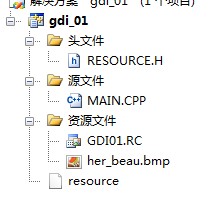 ------>
------>
 ----->
----->
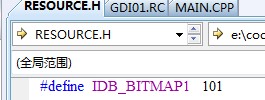 ----->
----->
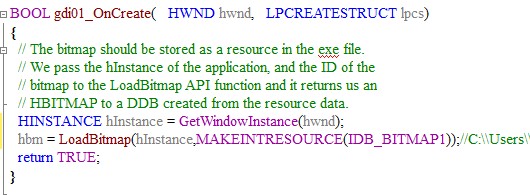
效果:
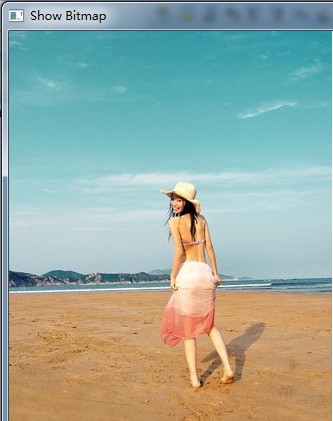
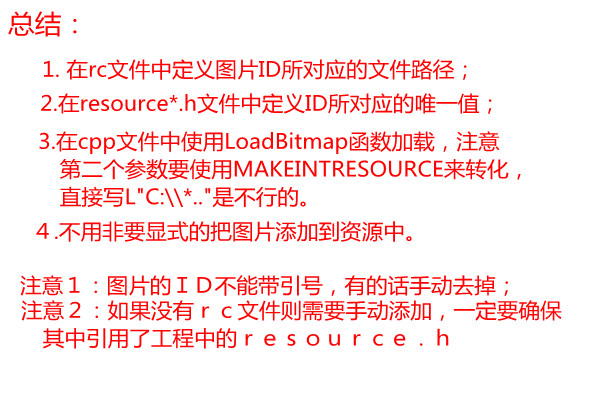
main.cpp源码:
#include <windows.h>
#include <windowsx.h>
#include "resource.h"
// Our DDB handle is a global variable.
HBITMAP hbm;
BOOL gdi01_OnCreate( HWND hwnd, LPCREATESTRUCT lpcs)
{
// The bitmap should be stored as a resource in the exe file.
// We pass the hInstance of the application, and the ID of the
// bitmap to the LoadBitmap API function and it returns us an
// HBITMAP to a DDB created from the resource data.
HINSTANCE hInstance = GetWindowInstance(hwnd);
//hbm = LoadBitmapW(hInstance,MAKEINTRESOURCE(IDB_BITMAP1));//C:\Users\Administrator.33XBYKMCA2C5EX4DesktopSpecPic
hbm = LoadBitmap(hInstance, MAKEINTRESOURCE(IDB_BITMAP1));
return TRUE;
}
void gdi01_OnDestroy( HWND hwnd)
{
// It is good practice to destroy all GDI objects when one is
// finished with them. Usually the sooner the better. Bitmaps
// can easilly expand to several megabytes of memory: A DDB is
// stored in the format of the device it is compatible with:
// On a 32 bit display a 256 color bitmap would be stored with
// four bytes per pixel.
DeleteObject(hbm);
PostQuitMessage(0);
}
void gdi01_OnPaint( HWND hwnd)
{
// Calling BeginPaint clears the update region that was set by calls
// to InvalidateRect(). Once the update region is cleared no more
// WM_PAINT messages will be sent to the window until InvalidateRect
// is called again.
PAINTSTRUCT ps;
HDC hdc = BeginPaint(hwnd,&ps);
// To paint with a DDB it first needs to be associated
// with a memory device context. We make a DC that
// is compatible with the screen by passing NULL to
// CreateCompatibleDC.
// Then we need to associate our saved bitmap with the
// device context.
HDC hdcMem = CreateCompatibleDC(NULL);
HBITMAP hbmT = SelectBitmap(hdcMem,hbm);
// Now, the BitBlt function is used to transfer the contents of the
// drawing surface from one DC to another. Before we can paint the
// bitmap however we need to know how big it is. We call the GDI
// function GetObject to get the relevent details.
BITMAP bm;
GetObject(hbm,sizeof(bm),&bm);
BitBlt(hdc,0,0,bm.bmWidth,bm.bmHeight,hdcMem,0,0,SRCCOPY);
// Now, clean up. A memory DC always has a drawing
// surface in it. It is created with a 1X1 monochrome
// bitmap that we saved earlier, and need to put back
// before we destroy it.
SelectBitmap(hdcMem,hbmT);
DeleteDC(hdcMem);
// EndPaint balances off the BeginPaint call.
EndPaint(hwnd,&ps);
}
LRESULT CALLBACK gdi01_WindowProc( HWND hwnd, UINT uMsg, WPARAM wParam, LPARAM lParam)
{
switch(uMsg)
{
HANDLE_MSG(hwnd,WM_CREATE,gdi01_OnCreate);
HANDLE_MSG(hwnd,WM_DESTROY,gdi01_OnDestroy);
HANDLE_MSG(hwnd,WM_PAINT,gdi01_OnPaint);
}
return DefWindowProc(hwnd,uMsg,wParam,lParam);
}
void gdi01_RegisterClass( HINSTANCE hInstance)
{
WNDCLASS wc =
{
0,
gdi01_WindowProc,
0,0,
hInstance,
LoadIcon(NULL,IDI_APPLICATION),
LoadCursor(NULL,IDC_ARROW),
(HBRUSH)(COLOR_WINDOW+1),
NULL,
L"GDI01"
};
RegisterClass(&wc);
}
int WINAPI WinMain( HINSTANCE hInstance, HINSTANCE hInstPrev, LPSTR lpszCmdLine, int nCmdShow)
{
gdi01_RegisterClass(hInstance);
HWND hwnd = CreateWindowEx(
0L,
L"GDI01",L"Show Bitmap",
WS_OVERLAPPEDWINDOW,
CW_USEDEFAULT,0,CW_USEDEFAULT,0,
HWND_DESKTOP,NULL,hInstance,NULL);
ShowWindow(hwnd,nCmdShow);
UpdateWindow(hwnd);
MSG msg;
while(GetMessage(&msg,0,0,0))
{
TranslateMessage(&msg);
DispatchMessage(&msg);
}
return msg.wParam;
}